
Special thanks to [Maarten], who stumbled upon this old gem of a geekhack thread by [suka]. It’s essentially a show and tell of their DIY keyboard journey, complete with pictures. [suka]’s interest started with a yen for ergonomic keyboard layout alternatives. They soon found the geekhack forum and started lurking around, practicing layouts like Neo and AdNW, which [suka] still uses today.
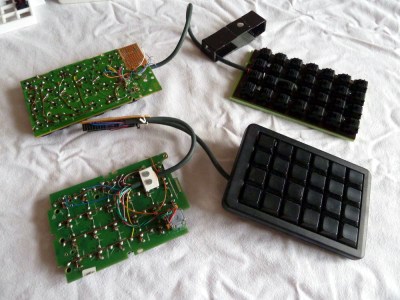 When it was time to stop lurking and start building something, [suka] got plenty of support from the community. They knew they wanted a split ortho with a trackpoint and plenty of thumb keys. [suka] started by building them from old Cherry keyboards, which are easier to come by in Germany.
When it was time to stop lurking and start building something, [suka] got plenty of support from the community. They knew they wanted a split ortho with a trackpoint and plenty of thumb keys. [suka] started by building them from old Cherry keyboards, which are easier to come by in Germany.
The first build was a pair of num pads turned landscape and wired up to a Teensy, but [suka] wanted those sweet, clacky Cherry MX switches instead of MLs. So the second version used a pair of sawed-off num pads from old MX boards.
When the Truly Ergonomic came out, it got [suka] interested in one-piece splits. Plus, they were tired of carrying around a two-piece keyboard. So their next build was a sexy monoblock split with a laser-sintered case and keycaps. But that was ultimately too uncomfortable, so [suka] went back to split-splits.
Everyone takes a different path into and through this hobby, and they’re all likely to be interesting. Is yours documented somewhere? Let us know.
What Could Have Been: The Dygma Raise
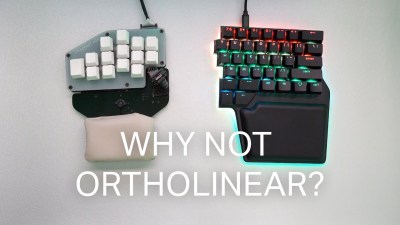 I do some streaming here and there, mostly for the sense of focus I get out of being live on camera. I like to find out what my people in chat are clacking on, and one of them told me they have a staggered split called the Dygma Raise. I hadn’t heard of it before that day, but this keyboard has been around for a few years now.
I do some streaming here and there, mostly for the sense of focus I get out of being live on camera. I like to find out what my people in chat are clacking on, and one of them told me they have a staggered split called the Dygma Raise. I hadn’t heard of it before that day, but this keyboard has been around for a few years now.
This same person told me that Dygma might make an ortholinear version sometime soon, but apparently Dygma wanted it that way from the beginning. According to the timely video below sent to the tips line by [deʃhipu], Dygma’s original plan was a split ortho with few keys and presumably a layer system.
So why did we end up with this half-hearted ergonomic that has more on hand to satisfy the staggered rectangle crowd? Well, because the staggered rectangle crowd is larger and has more money. But if you ask us, it wasn’t the ortholinear part that turned people off so much as the low key count. Asking people to go split and ortho and use layers from the get-go is simply too much at once.
It’s Complicated: Futaba MD Switches
So I picked up this bare TI-99/4A keyboard for building a cyberdeck, and it has some fairly interesting switches. There are 47 of these Futaba MD complicated linear switches, plus a single one that latches for the ALPHA LOCK key. These funny cylindrical switches are pretty large compared to Cherry MX switches, and they have MX-compatible stems.
And they’re aptly-named, too. These complicated linears have 16 parts to them in total, which is quite a count for a switch that has no audible click or tactile feel to it at all. Deskthority took one apart and they have a nice gallery showing each step of disassembly. I tried to do it for myself with a similar Futaba MD, but I just can’t get the legs to unscrew, which is supposed to be Step 1 of getting them apart.
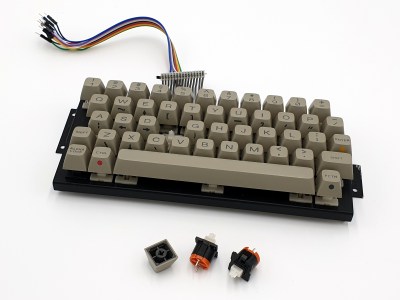
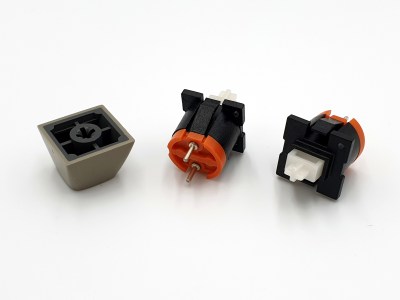
Cat-Like Typing Detected
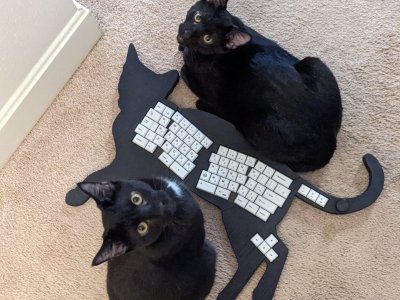 Anyone who owns both a cat and a keyboard knows that they are inextricably linked. Even if your cat never actually sits on top of your keyboard, there is probably enough hair in there to clone little Chairman Meow a couple times over.
Anyone who owns both a cat and a keyboard knows that they are inextricably linked. Even if your cat never actually sits on top of your keyboard, there is probably enough hair in there to clone little Chairman Meow a couple times over.
If you’re looking for your first split keyboard, the Alice layout is a good choice. But an Alice layout on a cat silhouette? We predict that this kitty’s gonna hold its value on r/mechmarket simply for the novelty. So don’t miss this Pikatea keyboard group buy, which comes in a rainbow of colors and a variety of key switches. It ends on December 15th or as soon as 50 of them are sold, whichever comes first.
Historical Clackers: the Namograph
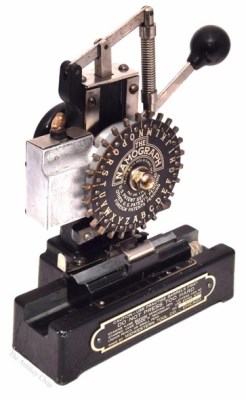
Remember the index typewriter? That’s the kind that doesn’t have a standard keyboard, just the alphabet and an arrow for choosing and printing one letter at a time. They still exist in the form of embossing label makers.
Here’s an index typewriter that was meant to personalize your pencil, pen, toothbrush, pipe handle, wallet, or whatever — the Namograph. It was a small machine that weighed only 7½ pounds and plugged into the wall. The Namograph didn’t sell well, and the company that made them from 1921 to 1922 never made any other product. Although they failed, the concept obviously did not — it lives on in hot foil stamping machines.
ICMYI: Model F restoration
[Epictronics] recently got a hold of an IBM Model F that some people might have deemed too far gone to bother with. It was missing its badge and about ten keycaps, which was enough to reveal just how much crud was strewn about the switch plate.
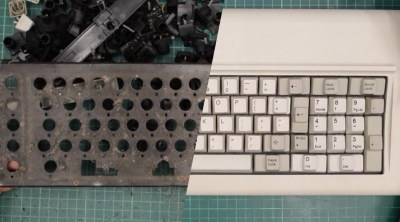 But [Epictronics] wasn’t worried about vintage crumbs. The biggest issue was the old, rotten foam inside. It took some doing, but they made a nice replacement with a sheet of neoprene, a big hole punch, and a lot of patience.
But [Epictronics] wasn’t worried about vintage crumbs. The biggest issue was the old, rotten foam inside. It took some doing, but they made a nice replacement with a sheet of neoprene, a big hole punch, and a lot of patience.
There’s a lot more to this restoration that gives plenty to learn from. Lacking the robotic equipment IBM would use to take the keyboard apart, [Epictronics] resorted to resting it face-down on a pair of pool noodle halves and whacking it just right with a rubber mallet to remove the back plate.
Once all the dirtier deeds were done, [Epictronics] moved on to aesthetics, removing a stain on the case with a careful application of car polish, and tightening up the coil on one end of the cable with some taped-up threaded rod and a heat gun.
Got a hot tip that has like, anything to do with keyboards? Help me out by sending in a link or two. Don’t want all the Hackaday scribes to see it? Feel free to email me directly.
0 Commentaires